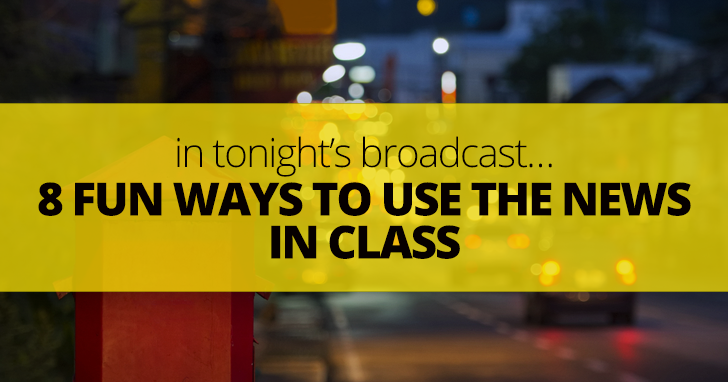In Tonight’s Broadcast…8 Fun Ways to Use the News in Class


You’re not alone, of course. Our younger students have grown up with cable news, and are probably very familiar with the format. This gives us a great opportunity to create an integrated-skills class with lots of language review and new vocabulary, but which also relies on the students’ creative and theatrical sides. It’s been a great success in my classroom and doesn’t take much time or effort to set up:

You could use actual news stories from that day (see my article on Using the News) but I recommend that the stories are partly or entirely fictional. This reduces the amount of reading and research, and increases the team participation, creativity and shared experience of the exercise. The teacher could create ten or more stories from which the students will choose two or three for their broadcast, or the students could be given a basic outline (the location and main event of the story) and create the details themselves. In any event, perhaps begin by brainstorming the most common topics for news stories:
Here are some examples of stories we created in class and then expanded upon:
Earthquake in Chile. The earthquake struck at 3am and measured 5.5 on the Richter scale. There are reports of several casualties but we will have to wait until morning to receive an update on the damage.
Celebrity Pregnancy. Jodie Nova, the extremely popular singer and charity representative, has become pregnant for the first time at the age of 32. She recently divorced her alcoholic husband, and is single.
Successful Docking in Space. The latest 3-man mission to the International Space Station (ISS) has arrived safely after a routine ascent. They will stay for six months, carrying out science experiments.
Suspected Virus in China. Details are scarce, but several people appear to have fallen ill after eating broccoli which may have been contaminated with a dangerous stomach virus. The government has refused to comment, or allow any health inspectors to visit the victims.
New Education Policy. The US government has announced new plans to close the gap between public and private schools. $200 billion will be invested in equipment, buildings and teacher training over the next 10 years. Teachers’ groups have complained that the policy is ‘too little, too late’.
As usual, it is best to avoid highly sensitive topics (terrorism, religion, disputed territory) and to bear in mind your students’ backgrounds when choosing topic areas. I strongly recommend against discussing China-related stories with a Chinese-dominated class, as they might find it difficult to divorce reality from the fiction this exercise is intended to create.
Divide the students into teams of between three and six. Depending on the story, each team will have:

The team should quickly choose their stories and brainstorm the details they will present. Which roles will be needed? Would it be better to interview an expert on typhoons, or a villager who has lost their house? Should the anchor interview a politician or someone affected by a policy decision? In which order will the stories be delivered? How much time should each story have?
This exercise has always worked best when the broadcast is scripted, and I recommend that the students write down the vast majority of what they’re going to say. Improvising can also work, but is likely to feel less like a cable news broadcast.
You might review or teach useful language for a news broadcast, such as:
Introducing the Story
Handing over to a Correspondent
Introducing an Expert
Introducing a Graphic or Statistic
Finishing the Broadcast
Emphasize the importance of rehearsing the broadcast before delivering it to the class. Everything will be more polished and prepared once the team has run it through once or twice. Monitor this and offer guidance on delivery, speed of speaking, eye contact, use of the ‘news language’ above, pronunciation and any grammar issues.
Given two or three stories on which to report, my students typically take 10-15 minutes to deliver the news. This includes handing over to correspondents and in-studio interviews with experts. Encourage classmates to listen respectfully, and perhaps ask some check questions after the broadcast, to make sure they were listening! Also, wait until the broadcast has finished to make any necessary corrections, so as not to interrupt the flow of the delivery.